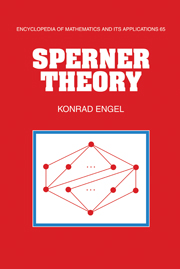Book contents
- Frontmatter
- Contents
- Preface
- 1 Introduction
- 2 Extremal problems for finite sets
- 3 Profile-polytopes for set families
- 4 The flow-theoretic approach in Sperner theory
- 5 Matchings, symmetric chain orders, and the partition lattice
- 6 Algebraic methods in Sperner theory
- 7 Limit theorems and asymptotic estimates
- 8 Macaulay posets
- Notation
- Bibliography
- Index
5 - Matchings, symmetric chain orders, and the partition lattice
Published online by Cambridge University Press: 08 January 2010
- Frontmatter
- Contents
- Preface
- 1 Introduction
- 2 Extremal problems for finite sets
- 3 Profile-polytopes for set families
- 4 The flow-theoretic approach in Sperner theory
- 5 Matchings, symmetric chain orders, and the partition lattice
- 6 Algebraic methods in Sperner theory
- 7 Limit theorems and asymptotic estimates
- 8 Macaulay posets
- Notation
- Bibliography
- Index
Summary
This chapter should be considered as a link between the preceding flow-theoretic (resp. linear programming) approach and the succeeding algebraic approach to Sperner-type problems. The main ideas are purely combinatorial. The powerful method of decomposing a poset into symmetric chains not only provides solutions of several problems, it is also very helpful for the insight into the algebraic machinery in Chapter 6. In particular, certain strings of basis vectors of a corresponding vector space will behave like (symmetric) chains.
Definitions, main properties, and examples
Throughout let P be a ranked poset of rank n : r(P). We say that the level Ni can be matched into the level Ni+1 (resp. Ni-1) if there is a matching of size Wi in the Hasse diagram Gi = (Pi, Ei) (resp. Gi-1 = (Pi-1, Ei-1)) of the {i, i + 1}- (resp. {i – 1, i}-) rank-selected subposet (recall that a matching is a set of pairwise nonadjacent edges or arcs).
Theorem 5.1.1. If there is an index h such that Ni can be matched into Ni+1 for 0 ≤ i ≤ h and Ni can be matched into Ni–1 for h < i ≤ n, then P has the Sperner property.
Proof. If we join the arcs of the corresponding matchings at all points that are both starting point and endpoint, we obtain a partition of P into saturated chains (isolated points are considered as 1-element chains). Each such chain has a common point with Nh. Consequently, we have Wh chains and Dilworth's Theorem 4.0.1 implies d(P) ≤ Wh, that is, d(P) = Wh.
Information
- Type
- Chapter
- Information
- Sperner Theory , pp. 179 - 207Publisher: Cambridge University PressPrint publication year: 1997
